Fiore dei Liberi
|
Fiore Furlano de'i Liberi
|
|
|---|---|

This master with a forked beard appears sporadically throughout both the Getty and Pisani Dossi mss., and may be a representation of Fiore himself.
|
|
| Born | c. 1350 Cividale del Friuli, Friuli (now Italy) |
| Died | after 1409 |
| Occupation | Diplomat, Fencing master, Mercenary |
| Language | Middle Italian, Renaissance Latin |
| Nationality | Italian |
| Notable works |
The Flower of Battle List of manuscripts
|
| Relatives | Benedetto de'i Liberi (father) |
|
B1.370.A Ms. M.0383
|
|
|---|---|
| The Morgan Library & Museum | |

Folia 13v–14r
|
|
| Date | before 1409 |
| Place of origin | Milan, Italy |
| Language(s) | Medieval Italian |
| Scribe(s) | Unknown |
| Author(s) | Fiore dei Liberi |
| Illuminated by | Unknown |
| Material | Vellum, in a modern binding |
| Size | 20 folia, 277×195 mm |
| Format | Double-sided; four illustrations per side, with text above |
| Condition | Incomplete |
| Script | Bastarda |
| Other | Catalog listing |
|
Ms. Ludwig XV 13
|
|
|---|---|
| The J. Paul Getty Museum | |

Folia 27v–28r
|
|
| Date | before 1409 |
| Place of origin | Venice, Italy |
| Language(s) | Medieval Italian |
| Scribe(s) | Unknown |
| Author(s) | Fiore dei Liberi |
| Illuminated by | At least two artists |
| Dedicated to | Niccolò III d'Este |
| Material | Parchment, in a pasteboard leather binding |
| Size | 49 folia, 279×206 mm |
| Format | Double-sided; four illustrations per side, with text above |
| Script | Bastarda |
| Other | Catalog listing |
|
Pisani Dossi Ms.
|
|
|---|---|
| Private collection | |

Folia 18v–19r
|
|
| Date | 10 February 1409 |
| Place of origin | Venice, Italy |
| Language(s) |
Medieval Italian Renaissance Latin |
| Scribe(s) | Unknown |
| Author(s) | Fiore dei Liberi |
| Illuminated by | Altichiero da Zevio (?) |
| Dedicated to | Niccolò III d'Este |
| Material | Parchment, in a cardboard folder |
| Size | 36 folia |
| Format | Double-sided; four to six illustrations per side, with text above |
| Script | Bastarda |
|
Mss. Latin 11269
|
|
|---|---|
| Bibliothèque nationale de France | |

Folia 14v–15r
|
|
| Date | after 1409 |
| Place of origin | Paris, France (?) |
| Language(s) | Renaissance Latin |
| Scribe(s) | Unknown |
| Author(s) | Fiore dei Liberi |
| Illuminated by | Unknown |
| Material | Parchment, with a pasteboard leather cover |
| Size | 44 folia, 255×195 mm |
| Format | Double-sided; two illustrations per side, with text above |
| Script | Bastarda |
| Exemplar(s) | Pisani Dossi Ms. |
| Other | Catalog listing |
Fiore Furlano de Cividale d'Austria, delli Liberi da Premariacco (Fiore dei Liberi, Fiore Furlano, Fiore de Cividale d'Austria; born ca. 1350; died after 1409) was a late 14th century knight, diplomat, and itinerant fencing master.
He is the earliest Italian master from whom we have an extant[update]martial arts manual. His Flower of Battle (Fior di Battaglia, Flos Duellatorum) is among the oldest surviving fencing manuals.
Fiore dei Liberi was born in Cividale del Friuli, a town in the Patriarchal State of Aquileia in the Friuli region of modern-day Italy, the son of Benedetto and scion of a Liberi house of Premariacco. The term Liberi, while potentially merely a surname, probably indicates that his family had imperial immediacy, either as part of the Edelfrei (nobili liberi, "free nobles"), the Germanic unindentured knightly class which formed the lower tier of nobility in the Middle Ages, or possibly of the rising class of Imperial Free Knights. It has been suggested by various historians that Fiore and Benedetto were descended from Cristallo dei Liberi of Premariacco, who was granted immediacy in 1110 by Emperor Henry V, but this has yet to be confirmed.
Fiore wrote that he had a natural inclination to the martial arts and began training at a young age, ultimately studying with "countless" masters from both the Italian and German parts of the Holy Roman Empire.
He also writes of meeting many "false" or unworthy masters who lacked even the limited skill he'd expect in a good student, and mentions that on five separate occasions he was forced to fight duels for his honor against certain of these masters whom he described as envious because he refused to teach them his art; the duels were all fought with sharp longswords, unarmored except for gambesons and chamois gloves, and he stated that he won each without injury.
...
Wikipedia
